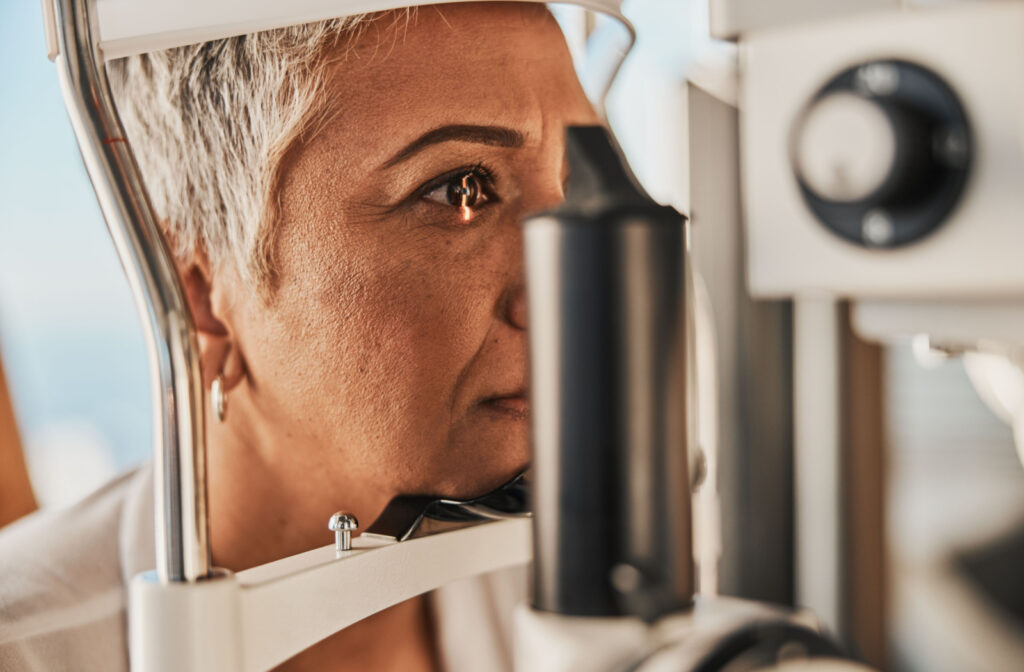Age-related macular degeneration (AMD) is a common eye condition that can affect the central part of your vision. It occurs when your macula, a small area in the center of your retina, deteriorates over time.
Your macula is responsible for sharp, detailed vision, allowing you to see fine details like words on a page or recognize faces. When AMD sets in, it can cause blurred or distorted vision, making it difficult to read, drive, or recognize faces. People often describe AMD’s effects as if there’s a dark or empty spot in the center of their vision, like looking through a smudged or foggy window.
Studies have shown certain gene variations can increase your chance of developing AMD and that the condition can be hereditary. If you have a family history of AMD, it’s a good idea to keep an eye out for any changes in your vision and make sure to visit your eye doctor regularly for eye exams focused on macular degeneration.
Understanding the 2 Types of AMD
There are 2 main types of AMD: dry and wet. Dry AMD is more common, making up 90% of all cases, and progresses slowly over time. It involves the buildup of drusen, tiny yellow deposits, on the macula. Wet AMD, on the other hand, is less common but often more severe. It occurs when abnormal blood vessels leak fluid into the macula, causing rapid and significant vision loss.
Symptoms of Dry & Wet AMD
Recognizing the signs of macular degeneration is crucial for early detection and intervention. The progression of your symptoms can vary depending on whether you have the dry or wet form of AMD.
If you have AMD, you may experience the following symptoms:
- Blurred Central Vision: You might notice a gradual blurring of your central vision, making it difficult to read small print or see fine details clearly.
- Difficulty Recognizing Faces: People’s faces may become harder to recognize, especially in low-light conditions or when looking directly at someone.
- Decreased Colour Sensitivity: Colours may appear less vibrant or faded compared to how they used to look.
- Need for Brighter Light: You might find yourself needing brighter light to perform tasks that were previously easier to do with normal lighting.
- Distorted Vision: Straight lines may appear wavy or crooked, and objects may seem distorted or shape-shifted.
- Blind Spots: You may notice blind spots or dark areas in the center of your vision, making it challenging to focus on specific objects.
Dry AMD progresses slowly, so these symptoms may develop gradually over time. If you have wet AMD, you may experience more sudden and severe symptoms. It’s essential to seek emergency eye care if you experience any sudden changes to your vision, as wet AMD can lead to significant, rapid vision loss if left untreated.

Risk Factors for AMD
AMD primarily affects older adults. Generally, it becomes more common as people age and can be more prevalent in individuals over the age of 55. Studies suggest that around 15–20 percent of individuals with AMD have at least 1 first-degree relative who also has the condition. But genetics is just 1 piece of the puzzle.
Other factors that can put someone at a higher risk for AMD include:
- Smoking
- Environmental factors like UV exposure
- High blood pressure
- Cardiovascular disease
Treatments for AMD
Unfortunately, there is currently no cure for AMD. However, there are steps you can take to slow its progression and manage the symptoms.
Your eye doctor may recommend dietary supplements containing certain vitamins and minerals that support macular health. Additionally, regular monitoring of your vision through routine eye exams is vital to detect changes early on.
One common approach to treating wet AMD is anti-VEGF therapy, where medications are injected into the eye to inhibit the growth of abnormal blood vessels. These injections can help prevent further vision loss and, in some cases, even improve vision. Anti-VEGF treatments are typically administered on a regular basis, as prescribed by your doctor. Other treatments, such as photodynamic therapy, may also be an option for wet AMD.
Each case of AMD is unique, and your optimal treatment plan may vary. It’s essential to consult your eye doctor to discuss your specific situation and determine the right course of action.
Eye Nutrition
Your diet plays a significant role in keeping your eyes healthy and preventing eye diseases like macular degeneration. Certain nutrients, such as vitamin C and zinc, have been shown to reduce the risk of serious eye conditions. At Dr. Bishop & Associates, we carry a range of ocular nutraceuticals that can supplement your diet and support your eye health.
You can incorporate key nutrients into your diet through the following foods:
- Spinach, kale, and collard greens (lutein and zeaxanthin)
- Oranges, berries, and red peppers (vitamins C and E)
- Salmon and tuna (omega-3 fatty acids)
- Almonds, walnuts, and chia seeds (vitamin E and omega-3s)
- Oysters, beef, and poultry (zinc)

Reduce Your Risk of AMD
Prevention plays a fundamental role in protecting your vision from macular degeneration, especially if you have a family history of AMD. By adopting a healthy lifestyle, consuming a nutrient-rich diet, and prioritizing regular eye exams, you can take proactive steps to help reduce your risk.
At Dr. Bishop & Associates, we offer macular degeneration eye exams to detect small changes in your vision and eye health that may not be obvious on the surface. Through regular screenings and proactive prevention, we can help preserve your macular health. Book a macular degeneration eye exam with us today.




